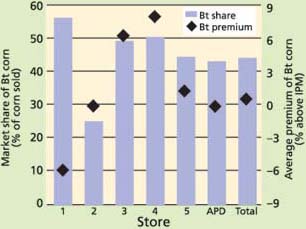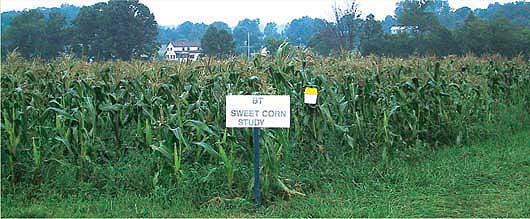All Issues
Sidebar: Consumers purchase Bt sweet corn
Publication Information
California Agriculture 58(2):103-103.
Published April 01, 2004
PDF | Citation | Permissions
Full text
Bt corn is one of several widely adopted genetically engineered (GE) crops. It contains a gene from a soil bacterium (Bacillus thuringiensis) that causes the corn to produce a protein toxic to European corn borer and other insect pests, essentially building worm control into the corn. This form of pest control reduces pesticide costs and may improve yields; it is especially beneficial for sweet corn, which has higher insecticide loads than most other fresh-market vegetables. Producer benefits from choosing to plant a Bt sweet corn are clear, but uncertainty about consumer willingness to purchase GE corn reduces those benefits.
A study designed to measure consumer preferences for Bt sweet corn was conducted in central Pennsylvania in summer 2001. The goal was to assess consumer willingness to purchase Bt sweet corn and determine how consumers responded to price variations. Two types of corn were grown at the Penn State farm: one contained the Bt gene, and the other was a related variety that had not been genetically engineered. Corn was clearly labeled as either “Bt Sweet Corn” or “IPM Sweet Corn” and sold side-by-side at five stores in central Pennsylvania and at Penn State's Ag Progress Days. The IPM (produced using integrated-pest-management methods) and Bt sweet corn were described briefly in a brochure available to consumers in each store. The relative prices of Bt and non-Bt corn were varied from location to location and week to week. Retailers were encouraged to set the price of the IPM corn according to market conditions, but were instructed to sell the Bt cultivar at either the same price as the IPM corn, 15% less or 15% more. Sellers recorded how much corn of each type was sold each week.
Fig. 1. Market shares (bars, labeled on left axis) and corresponding average price premiums (diamonds, labeled on right axis) for Bt sweet corn by store, plus at Penn State's Ag Progress Days (APD). Corn labeled “Bt Sweet Corn” was sold side-by-side with corn labeled “IPM Sweet Corn”; a brochure explained the difference between the transgenic (Bt) and integrated-pest-management (IPM) products.
Results from a consumer-preference study in central Pennsylvania suggest that there may be a viable market for Bt sweet corn, above.
The results from this geographically specific study cannot be interpreted as nationally representative, but they suggest that there is a viable market for Bt sweet corn. The overall market share of Bt sweet corn was 44%, shown in figure 1 along with the store-specific market shares. Price seems to have played a fairly minor role in consumer choices, as indicated by the fairly large market shares of Bt sweet-corn in stores 3 and 4, where price premiums were higher, on average, than in other stores.






